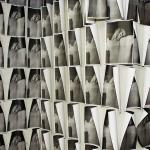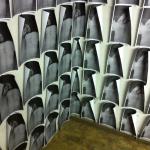The installation is based on one single picture 'ROXY'; a color photo showing a blonde girl leaning against a bright blue wall, her back turned to the viewer. This photo is not shown. In stead 500 black & white A4 copies of the color photo were made. These copies were used to cover an entire exhibition space. They were hung with pushpins next to each other until every part of the room was covered. The visitors were invitedB to take a copy back home with them. They had to take it off the wall themselves. This meant making a choice out of 500 exact copies. On the back of the copy a message was written: bsend picture of picture in new destination to roxy@ulrikebiets.comb. The artist asked the visitors to give the copy a new place in their own home, photograph it, and send her the photos afterwards.
The installation is a very organic work, it starts to transforms from the first moment it is hung. The paper starts to curl due to the humidity of the room, the people walking by create wind moving the copies, some copies may fall down, others are taken off the wall later on. bRoxyb reveals and conceals itself while being exposed. The work of art is made by the artist as well as by the (interactive) spectator, the exhibition space and the laws of nature.
It is impossible to determine what the 'original artwork' is. Is it the digital file? Or is it the original print from which the copies were made? By hanging 500 cheap copies of that artwork in one room, is the value of that one photo taken down? Or does one actually add value, and is the installation the real work of art? Are we talking about the installation at the beginning or at the end of the exhibition? Or is it maybe the single copy that goes back home with the visitor; does it become an unique piece again when hung in ones home? Does any of this haveB any value? Can one determine what is original? What is most valuable?
***
Ulrike Biets (1981) is a photographer and an artist based in Brussels, Belgium. www.ulrikebiets.com




